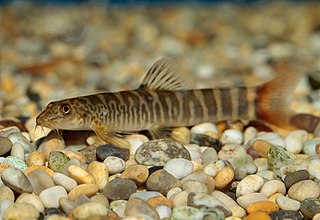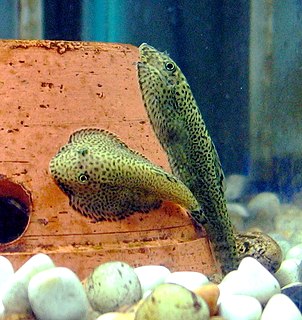
Cobitidae, also known as the True loaches, is a family of Old World freshwater fish. They occur throughout Eurasia and in Morocco, and inhabit riverine ecosystems. Today, most "loaches" are placed in other families. The family includes about 260 described species. New species are being described regularly.

The hillstream loaches or river loaches are a family, the Balitoridae, of small fish from South, Southeast and East Asia. The family includes about 99 species. They are sometimes sold as "lizardfish" or "flossensaugers". Many of the species are popular for aquaria, species in the genus Sewellia are most commonly sold in the aquaria trade. They have a number of similarities with the Cobitidae, their sibling family of "loaches", such as multiple barbels around the mouth. They should not be confused with the loricariids, which look similar but are a family of catfish.

Lepidocephalichthys is a genus of ray-finned fish in the Cobitidae family.

Nemacheilus is a genus of stone loaches native to Asia.

Schistura is a genus of fish in the stone loach family Nemacheilidae native to the streams and rivers of the southern and eastern Asia. Some of these species are troglobitic.
Schistura horai is a species of ray-finned fish in the stone loach genus Schistura. It is found in India and Pakistan. It is named in honour of the ichthyologist Sunder Lal Hora (1896-1955), who was the Director of the Zoological Survey of India and who collected the type specimen in 1926 in Himachal Pradesh.
Schistura prashadi is a species of ray-finned fish, a stone loach, in the genus Schistura. Some authorities place it in the genus Physoschistura It is known from just three localities in the Chindwin River drainage in Manipur, India. It is a benthic species of hill streams, preferring well oxygenated, clear, flowing water. The specific name honours Baini Prashad (1894-1969) who was an Assistant Superintendent at the Zoological Survey of India, who gave "every possible encouragement” to the describer of this species, Sunder Lal Hora.

Loaches are fishes of the superfamily Cobitoidea. They are freshwater, benthic (bottom-dwelling) fishes found in rivers and creeks throughout Eurasia and northern Africa. Loaches are among the most diverse groups of fishes; the 1249 known species of Cobitoidea comprise about 107 genera divided among 9 families.
Aborichthys is a genus of stone loaches found in streams of India with one species also found in Myanmar.
Annamia is a small genus of gastromyzontid loaches native to Southeast Asia. There are two species, though one of them is of doubtful validity and identity:

Neonoemacheilus is a genus of Asian stone loaches.
Paraschistura is a genus of stone loaches most of which occur in Central, South and Western Asia.
Physoschistura is a genus of fish in the family Nemacheilidae found mostly in Southeast Asia.
Travancoria is a small genus of hillstream loaches endemic to India.
The Nemacheilidae, or stone loaches, are a family of cypriniform fishes that inhabit stream environments, mostly in Eurasia, with one genus, Afronemacheilus found in Africa. The family includes about 630 species.

Balitoropsis also known as the lizard loaches is a genus of hillstream loaches native to eastern Asia.

The Gastromyzontidae are a family of loaches native to China and Southeast Asia, where typically found in streams and rivers with a fast current. The family includes about 137 species in eighteen genera. This family was resurrected by M. Kottelat in his review and revision of the loaches in 2012.
Homalopteroides is a genus of hillstream loaches native to Southeast Asia.
Indotriplophysa is a subgenus of the stone loach genus Triplophysa native to central Asia. It is regarded by some authorities as a valid genus in its own right.

Pseudohomaloptera is a genus of ray-finned fish in the family Balitoridae.










